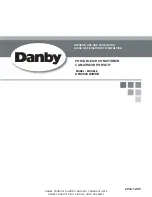
Installation
WARNING
Hazard of Explosion!
Never use an open flame to detect gas leaks. Explosive conditions may occur. Use a
leak test solution or other approved methods for leak testing. Failure to follow
recommended safe leak test procedures could result in death or serious injury or
equipment or property-only-damage.
WARNING
Hazard of Explosion!
Use only dry nitrogen with a pressure regulator for pressurizing unit. Do not use
acetylene, oxygen or compressed air or mixtures containing them for pressure testing.
Do not use mixtures of a hydrogen containing refrigerant and air above atmospheric
pressure for pressure testing as they may become flammable and could result in an
explosion. Refrigerant, when used as a trace gas should only be mixed with dry
nitrogen for pressurizing units. Failure to follow these recommendations could result in
death or serious injury or equipment or property-only damage.
After the installation of refrigerant lines to both the outdoor and indoor units are completed, the
flare connections must be checked for leaks. Pressurize through the service valve ports, the indoor
unit and field refrigerant lines with dry nitrogen to 350-400 psi. Use soap bubbles or other leak-
checking methods to see that all flares are leak-free! If not, release pressure; then repair!
SYSTEM EVACUATION
Note:
Since the oudoor unit has a refrigerant charge, the gas and liquid line valves must remain
closed.
1.
Upon completion of leak check, evacuate the refrigerant lines and indoor coil before opening
the gas and liquid line valves.
2.
Attach appropriate hoses from manifold gauge to gas and liquid line pressure taps.
3.
Attach center hose of manifold gauges to vacuum pump.
4.
Evacuate until the micron gauge reads no higher than 350 microns.
5.
Close off valve to vacuum pump and observe the micron gauge. If gauge pressure rises
above 500 microns in one (1) minute, then evacuation is incomplete or system has a leak.
6.
If vacuum gauge does not rise above 500 microns in one (1) minute, the evacuation should be
complete.
7.
Blank off vacuum pump and micron gauge, close valves on manifold gauge set.
Note:
DO NOT VENT REFRIGERANT INTO THE ATMOSPHERE.
8.
The liquid line shut-off valve can now be opened. Remove shut-off-valve cap. Fully insert hex
wrench into the stem and backout counterclockwise open.
Vacuum Pump and Leak Inspection
MS-SVN21A-EN
12
Содержание 2MCW0-G
Страница 6: ...RU 0 PRGHOV SRZHU LQSXW IURP LQGRRU XQLW 0 PRGHO SRZHU LQSXW IURP RXWGRRU XQLW MS SVN21A EN 6...
Страница 18: ...MS SVN21A EN Figure 4 2MWW0512G9 Heat pump indoor units Figure 5 2MCW0518G1 Cooling only indoor units 18...
Страница 21: ...06 691 1 LJXUH11 2TTK0518GB Cooling only outdoor units 10 2MWW0530G1 2MWW0530GB Heat pump indoor units 21...
Страница 26: ...20 2TWK0530G1 2TWK0530GB Heat pump Outdoor unit MS SVN21A EN Figure 21 2TWK0509GB Heat pump outdoor units 26...
Страница 27: ...06 691 1 LJXUH22 2TWK0512GB Heat pump outdoor units 27...













































